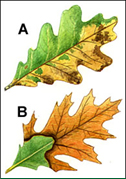Earlier this month, the NY State Dept. of Environmental Conservation issued a press release about the first known case of oak wilt, a serious tree disease, on Long Island. In June an arborist spotted symptoms of the disease in four trees in the Town of Islip and submitted samples from them to the Cornell Plant Disease Diagnostic Clinic, where the disease was identified. No treatment for oak wilt is known to contain and kill it other than removing infected trees and surrounding host oak trees, which was done in Islip. This is the second place in New York where the disease has been seen, the first being in Schenectady County in 2008 and 2013.

Note different patterns of infection on the white oak leaf (A), with its round lobes, and the red oak (B), with its pointy lobes.
Oak wilt appeared in the Great Lakes Region in 1944 and has since spread throughout the eastern United States, killing thousands of oak trees each year. Caused by the fungus Ceratocystis fagacearum, the disease creates blockage in the xylem vessels (sapwood) that conduct water within trees, slowing water delivery until leaves wilt and drop off. Red oaks succumb more quickly to the disease than white oaks and typically die within a few weeks of infection.
Oak wilt spreads three ways:
- through underground root systems
- through beetles that colonize infected oak trees and carry oak wilt to other trees
- through the movement of firewood within and out of areas where trees are infected
If you witness unusual leaf wilting and drop off on oak trees where you live, please call the NYSDEC Forest Health Information Line toll-free at 1-866-640-0652 to report it.
To learn more about the symptoms of oak wilt and how to submit samples of oak trees suspected of having it, click here to visit the 2016 Oak Wilt Update on the Cornell Plant Disease Diagnostic Clinic website. This You-tube video Oak Wilt in NY (made by Dr. George Hudler in 2008 after the first outbreak of oak wilt upstate) is very helpful in walking you through how to identify red and white oaks and how to prepare plant samples to submit for diagnostic testing.
Robin Simmen is Community Horticulture Specialist for CCE Suffolk. She can be reached at rls63@cornell.edu or at 631-727-7850 x215.

